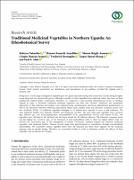Traditional Medicinal Vegetables in Northern Uganda: An Ethnobotanical Survey

View/
Date
2021Author
Nakaziba, Rebecca
Anyolitho, Maxson Kenneth
Amanya, Sharon Bright
Sesaazi, Crispin Duncan
Byarugaba, Frederick
Ogwal-Okeng, Jasper
Alele, Paul E.
Metadata
Show full item recordAbstract
Background. A wide range of indigenous vegetables grow in Uganda especially during rainy seasons but scarcely during droughts,
except those that are commercially grown. Although a number of these vegetables have medicinal values, they have not been
satisfactorily studied besides conservation. Therefore, we conducted a cross-sectional ethnobotanical survey in Northern
Uganda in order to document traditional medicinal vegetables and their uses. Methods. Qualitative and quantitative
approaches of data collection and analysis were employed using semistructured, interviewer-administered questionnaires as
well as key informant interviews following international ethical codes. Fidelity levels and informant consensus factors were
also calculated. Results. 13 traditional vegetables belonging to 10 families were reported to serve as folk medicines. The
most dominant families were Fabaceae (23.08%) and Solanaceae (15.38%). The most often used vegetables were Corchorus
spp., Hibiscus spp., and Asystasiagangeticafor musculoskeletal (51%), gastrointestinal (34.3%), and malaria (31.8%). The
vegetables were cultivated in the backyard and the leaves stewed for the different ailments. The informant consensus factor
was the highest for Corchorus spp., in the treatment of joint pain/stiffness (0.92-1) while the highest fidelity level was
(60.42%) for Amaranthus spp., in the management of anemia. Conclusions. Northern Uganda has numerous traditional
vegetables with medicinal benefits. Diseases treated range from gastrointestinal to reproductive through musculoskeletal
abnormalities. The community obtains vegetable leaves from the backyard and stews them regularly for the medicinal
purposes with no specific dosage. Therefore, we recommend studies to verify in laboratory models the efficacy of these
vegetables and standardize the dosages
Collections
- Research Articles [41]
